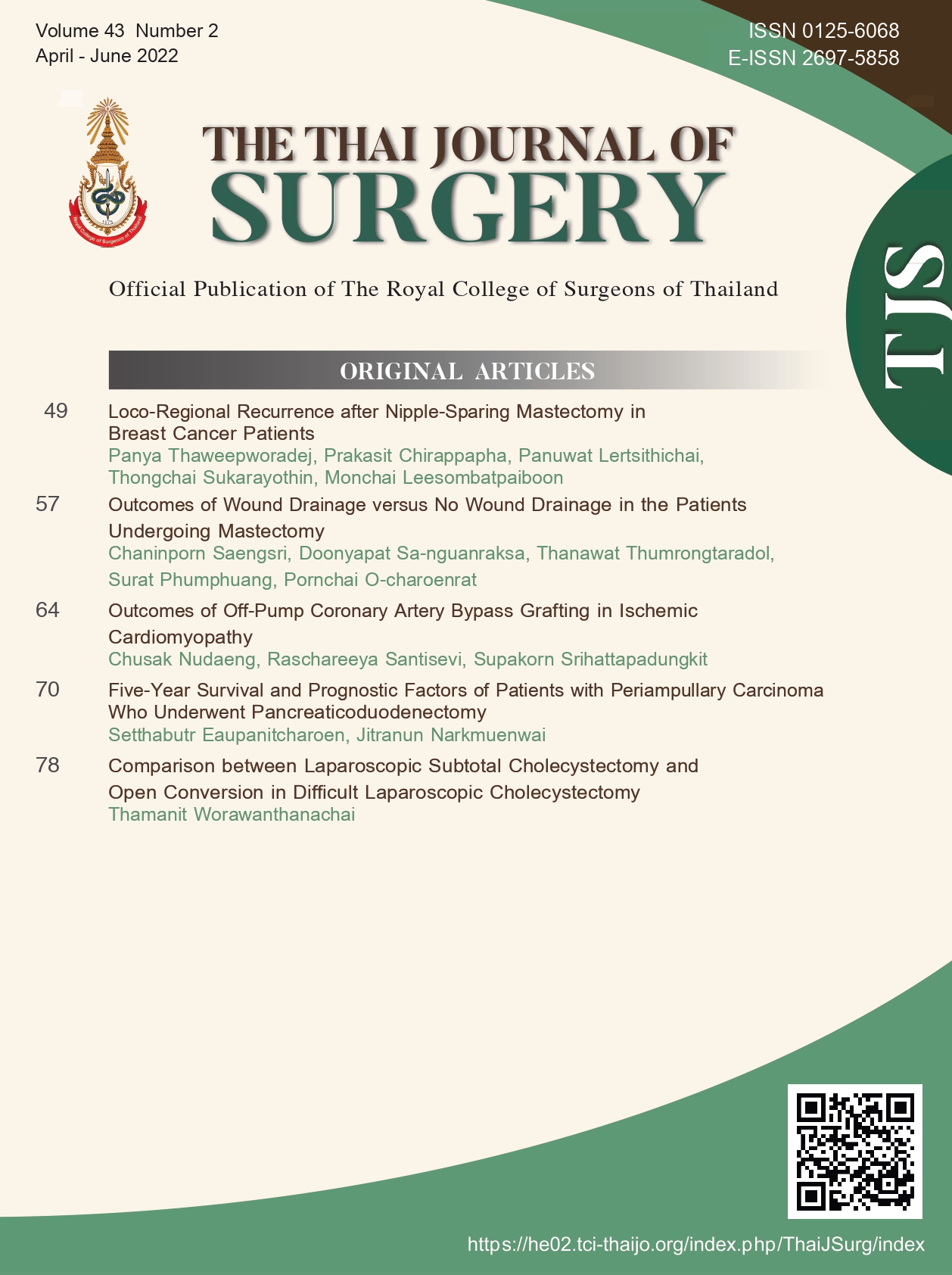Outcomes of Wound Drainage versus No Wound Drainage in the Patients Undergoing Mastectomy
Outcomes of Wound Drainage vs No Wound Drainage
Keywords:
Mastectomy, Seroma, Suction drainageAbstract
Background and objective: Seroma formation is the most common complication after total mastectomy or axillary lymph node dissection (ALND). The role of drainage is still controversial since some evidence suggests that it does not prevent the formation of seroma. This study aimed to evaluate seroma formation and postoperative complications in patients undergoing mastectomy with or without drainage.
Patients and Methods: A cohort of female patients with breast cancer or other breast conditions were retrospectively studied at the Division of Head Neck and Breast Surgery, Department of Surgery, Siriraj Hospital from November 2018 to August 2019. The patients were divided into drain and no drain groups. Demographic data, seroma formation, and postoperative complications were recorded and compared.
Results: A total of 129 patients were included in this study, 67 patients with drainage and 62 patients without drainage. The incidence of seroma formation was similar between the two groups. The total volume of aspirated seroma was significantly higher in the no drain group (p = 0.010). When combining the volume of seroma (drained + aspirated), the volume in the drain group was significantly higher than that in the no drain group (p = 0.020). The number of aspirations was higher in the drain group: 2 (0-9) vs 3 (0-14), p = 0.031. The patients in the no drain group had a significantly shorter length of hospital stay, 2.0 (1.0-3.0) vs 4.0 (2.0-10.0) days, p < 0.001.
Conclusions: No drainage is a feasible option in patients undergoing mastectomy in terms of reducing hospital stay but not increasing the incidence of symptomatic seroma and wound complications compared to routine drain placement.
References
Sa-Nguanraksa D, Sasanakietkul T, Kulprom A, et al. Gail model underestimates breast cancer risk in Thai population. Asian Pac J Cancer Prev 2019;20:2385-9.
Veronesi U, Cascinelli N, Mariani L, et al. Twenty-year follow-up of a randomized study comparing breast-conserving surgery with radical mastectomy for early breast cancer. N Engl J Med 2002;347:1227-32.
Polchai N, Sa-Nguanraksa D, Numprasit W, et al. A comparison between the online prediction models CancerMath and PREDICT as prognostic tools in Thai breast cancer patients. Cancer Manag Res. 2020;12:5549-59.
Pan XF, Huan JL, Qin XJ. Potential risk factors for the development of seroma following mastectomy with axillary dissection. Mol Clin Oncol 2015;3:222-6.
Agrawal A, Ayantunde AA, Cheung KL. Concepts of seroma formation and prevention in breast cancer surgery. ANZ J Surg 2006;76:1088-95.
Pogson CJ, Adwani A, Ebbs SR. Seroma following breast cancer surgery. Eur J Surg Oncol 2003;29:711-7.
Srivastava V, Basu S, Shukla VK. Seroma formation after breast cancer surgery: what we have learned in the last two decades. J Breast Cancer 2012;15:373-80.
Chen CY, Hoe AL, Wong CY. The effect of a pressure garment on post-surgical drainage and seroma formation in breast cancer patients. Singapore Med J 1998;39:412-5.
Conversano A, Mazouni C, Thomin A, et al. Use of low-thrombin fibrin sealant glue after axillary lymphadenectomy for breast cancer to reduce hospital length and seroma. Clin Breast Cancer 2017;17:293-7.
Archana A, Sureshkumar S, Vijayakumar C, et al. Comparing the harmonic scalpel with electrocautery in reducing postoperative flap necrosis and seroma formation after modified radical mastectomy in carcinoma breast patients: a double-blind prospective randomized control Trial. Cureus 2018;10:e2476.doi:10.7759/cureus.2476.
Andeweg CS, Schriek MJ, Heisterkamp J, et al. Seroma formation in two cohorts after axillary lymph node dissection in breast cancer surgery: does timing of drain removal matter? Breast J 2011;17:359-64.
Baas-Vrancken Peeters MJ, Kluit AB, Merkus JW, et al. Short versus long-term postoperative drainage of the axilla after axillary lymph node dissection. A prospective randomized study. Breast Cancer Res Treat 2005;93:271-5.
Thomson DR, Sadideen H, Furniss D. Wound drainage after axillary dissection for carcinoma of the breast. Cochrane Database Syst Rev 2013:CD006823.doi: 10.1002/14651858.CD006823.pub2.
Purushotham AD, McLatchie E, Young D, et al. Randomized clinical trial of no wound drains and early discharge in the treatment of women with breast cancer. Br J Surg 2002;89:286-92.
Jain PK, Sowdi R, Anderson AD, et al. Randomized clinical trial investigating the use of drains and fibrin sealant following surgery for breast cancer. Br J Surg 2004;91:54-60.
Soon PS, Clark J, Magarey CJ. Seroma formation after axillary lymphadenectomy with and without the use of drains. Breast 2005;14:103-7.
Taylor JC, Rai S, Hoar F, et al. Breast cancer surgery without suction drainage: the impact of adopting a 'no drains' policy on symptomatic seroma formation rates. Eur J Surg Oncol 2013;39:334-8.
Troost MS, Kempees CJ, de Roos MAJ. Breast cancer surgery without drains: no influence on seroma formation. Int J Surg 2015;13:170-4.
Baker E, Piper J. Drainless mastectomy: Is it safe and effective? Surgeon 2017;15:267-71.
Kontos M, Petrou A, Prassas E, et al. Pressure dressing in breast surgery: is this the solution for seroma formation? J BUON 2008;13:65-7.
Classe JM, Berchery D, Campion L, et al. Randomized clinical trial comparing axillary padding with closed suction drainage for the axillary wound after lymphadenectomy for breast cancer. Br J Surg 2006;93:820-4.
Downloads
Published
How to Cite
Issue
Section
License
Copyright (c) 2022 The Royal College of Surgeons of Thailand

This work is licensed under a Creative Commons Attribution-NonCommercial-NoDerivatives 4.0 International License.
Articles must be contributed solely to The Thai Journal of Surgery and when published become the property of the Royal College of Surgeons of Thailand. The Royal College of Surgeons of Thailand reserves copyright on all published materials and such materials may not be reproduced in any form without the written permission.



